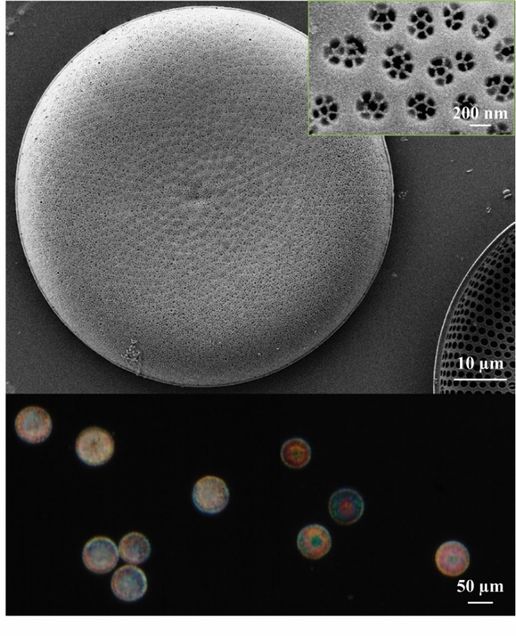Diatoms, which are microscopic unicellular algae often referred to as “jewels of the sea” and “living opals,” have a fascinating nanoscale porous structure on their silica exoskeletons called frustules. These structures display vibrant colors and intricate patterns. In work featured on the cover of Advanced Materials, Xin Zhang, Xiaohang Xie, and their collaborators utilized the intriguing natural design of diatom frustule to develop hierarchical metamaterials that achieve visible light absorption and subwavelength color printing.
Professor Xin Zhang (ME, ECE, BME, MSE) is renowned for her innovative work in creating metamaterials, which are artificially designed materials with properties not found in nature. Xiaohang Xie, a doctoral student in Zhang’s lab, study the properties and functions of a natural material to enhance metamaterial designs.
“The nanopattern of diatom frustules is the result of natural biological evolution and provides a fresh perspective for designing metamaterials,” says Zhang. “Learning from and being inspired by nature is something I’ll never tire of.”

After careful observing the hierarchical nanopores of the diatom frustule and understanding its unique structure, they decided to mimic these properties to create advanced artificial metamaterials. The diatom-inspired hierarchical nanopatterns not only achieve near-unity absorption but also function as hexagonal pixels for high-resolution color printing. The study shows that variations in nanoparticle diameter and inter-unit-cell distance can shift and broaden resonance peaks, allowing for color reproduction with high uniformity and fidelity.
“The high frequency of visible light requires smaller feature sizes for interaction, which demands precision in nanofabrication,” says Xie. “All the effort is worthwhile when I see the various colors reflected under the microscope.”
Visible light can be directly perceived by human eyes, and its spectrum encodes color. By varying the geometric patterns of the hierarchical structure, the RGB colors are demonstrated with smooth transitions. To further showcase the applicability of this technique for color prints and related applications, the letters of “BU” are chosen to color printed by such hexagonal pixel and presented with notable detail and color rendition on a nanometer scale.

Preserving the hierarchical nanopattern in a metamaterial introduces promising paths for multifunctional metamaterial design, with potential applications in thermal energy converters, thermal emitters, anti-counterfeiting, and more. The ability to produce subwavelength color prints highlights the practical potential of these metamaterials. Moreover, by directly using diatom frustule as shadow masks for metallic deposition and bio-template assisted synthesis, diatom frustule-inspired hierarchical structures hold significant potential for large scale production at a low cost.
